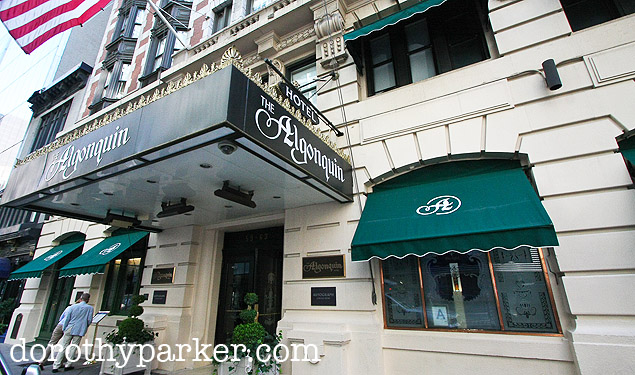The DPSNY was sent a press release today from the Algonquin Hotel about the big changes happening this month. Here it is:
Matilda The Cat Takes Long-Awaited Vacation: The Algonquin Hotel Undergoes $3 Million Restoration & Closes For First-Time in 102 Years
Legendary Hotel to Refurbish All Public Spaces & Guestrooms
New York, NY — 6/2/04 The Algonquin Hotel will be sending its famed resident cat, Matilda, off on her first-ever vacation when it closes for the first time in its 102-year history to complete a $3 million renovation.
Starting June 27th, the literary landmark, which opened in 1902 and was the home of the famous Algonquin Round Table and the birthplace of the New Yorker magazine, will refurbish its public spaces and guestrooms. The work comes on the heels of a five-year, $5 million capital improvement project.
“Staying open while completing this work would not have been consistent with the Algonquin’s reputation as an oasis of quiet civility in the center of our bustling city,” said General Manager Anthony Melchiorri. “The closing also enables us to complete the work speedily and efficiently, thereby permitting us to reopen at the end of July freshly prepared to welcome guests and visitors in a setting that maintains our traditions while enhancing our valued guests’ comfort and convenience.”
The restoration will embrace all public spaces, including the world famous Oak Room cabaret, the Round Table Room, where Dorothy Parker and her witty companions met, and the legendary Lobby, frequented by legends of stage, film and literature such as the Barrymores, Richard Burton and Elizabeth Taylor and William Faulkner (who wrote his 1950 Nobel Prize address in his suite), among many others. One of the additions to the lobby will be wireless fidelity access. Tables and fixtures in the dining and entertainment outlets will be refinished, carpeting replaced and furniture reupholstered.
All 174 rooms and suites will be updated to offer Internet connections, with most of the rooms also boasting new flat screen television sets and larger workstations. The decor will be brightened with vibrant new colors and designer fabrics in window treatments, furniture and bedding. Travelers will sleep nestled in the new all-white Algonquin Beds, featuring duvets and 350-thread count sheets. So confident is the hotel that the new ultra-comfortable beds will be a sleep-altering experience that they will be available for purchase. New artwork, in the form of innovative black and white photographs of the hotel, will grace guestrooms. Most bathrooms will offer more space and new vanities.
What won’t be changed? The original and exclusive New Yorker wallpaper, custom-designed by New Yorker cartoonist Robert Mankoff, will remain a point of interest to guests as they stroll through the corridors. Complimentary copies of the magazine will greet guests as they enter their rooms and suites. Posted on tiny plaques outside guestrooms will be quotes from members of the Round Table.
“Our goal,” says Melchiorri, “is for the hotel to look the same but feel better. If you sit on it, walk on it, or touch it, it will be restored or renewed. We are not changing the character of our rooms or our hotel, we’re burnishing it.”
Algonquin Hotel Fun Facts:
Matilda, the hotel’s resident cat, is quite the star. She is the subject of the book, Algonquin Cat, illustrated by Hilary Knight, the illustrator also of the famed Eloise books. Matilda roams the lobby, checks out incoming guests and visitors from her vantage point, makes friends with children of guests and makes sure to keep solo visitors company while they read or sip an Algonquin Signature Cocktail in the lobby. Matilda is deciding whether to spend her holiday in the South of France or a chic pet spa in Manhattan.
The New Yorker’s legendary editor Harold Ross dreamed about creating a magazine “not for the lady from Dubuque” while on the staff of Stars & Stripes in Paris during World War I along with future members of the Round Table, Alexander Woollcott and Franklin P. Adams. He finally persuaded his fellow poker player (from the Thanatopsis and Inside Straight Club on the Algonquin’s second floor), Raoul Fleischmann (of the yeast fortune), to spend $25,000 to help him start the magazine, and several more installments of $25,000 from the generous Mr. Fleischmann helped get the New Yorker on its feet.
The famed Algonquin Round Table officially began in 1919, when a serendipitous gathering of friends came together to celebrate the safe return of Alexander Woollcott from his service as a war correspondent, and the resumption of his role as resident drama critic for the New York Times. That lunch, in what was then the Pergola Room (the present Oak Room), was so enjoyable that the newly formed group—Dorothy Parker, Robert Benchley, Woollcott, Robert E. Sherwood, Franklin P. Adams, Heywood Broun and soon thereafter Edna Ferber met daily for lunch and soon moved into the main dining room. Until the early 30’s the Round Table group remained the most quoted circle of friends in literary history – wittier and less snobbish than Bloomsbury, less poetic than Catullus Circle in ancient Rome. With a decade of memories, the group slowly drifted away, some to Hollywood, some to playwriting, some to radio. The Round Table was the subject of The Ten-Year Lunch, Aviva Slesin’s Academy Award winning documentary of 1987.
The Algonquin was named “one of America’s 10 Best Historic Hotels” by Historic Traveler magazine, further noting its historical contributions to the City of New York.

